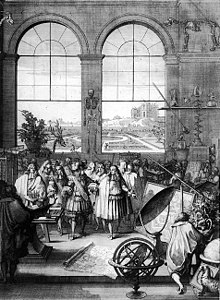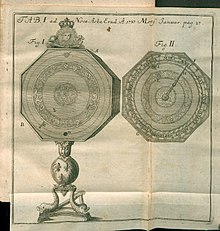French Academy of Sciences
The French Academy of Sciences (in French, Académie des sciences) is the French institution that: «Encourages and protects the spirit of research, and contributes to the progress of sciences and applications”. It was created in 1666, during the reign of Louis XIV under the patronage of his prime minister Jean-Baptiste Colbert. It is one of the five French academies that make up the current Institute of France.
It was the first institution to adopt the metric system as a universal system.
History
The Academy of Sciences owes its origin to the Colbert project to create a general academy. It is also inscribed in the line of various circles of sages that meet in the seventeenth century, around a patron or an erudi personality. Colbert chooses a small group of sages who gather on December 22, 1666 in the king's library, and there they have working sessions. The first thirty years of existence of the Academy were relatively informal, the new institution had not received status.Official page of the Academy
On April 20, 1699, Louis XIV gave the Royal Academy of Sciences its first regulations: initially made up of 70 members, the Academy received the title of royal and was installed in the Louvre.
During the 18th century he contributed to the scientific movement of his time through his publications, and played an advisory role for power. On August 8, 1793, the Convention abolishes all the academies. Two years later, on August 22, 1795, a "National Institute of Sciences and Arts" was created in its place, regrouping the old scientific, literary and artistic academies. The first class of the "Institute of Physical and Mathematical Sciences" was the largest, with 66 members out of 144.
In 1816, the Academy of Sciences regained its autonomy by participating in the Institute of France. The head of state is their protector. In 1835, under the influence of François Arago, the "CaCTAS de la Académie des Sciences" were created, which once again became a major instrument for disseminating the work of French and foreign scientists.
Purposes
In order to correctly understand the objectives, status and way of working of the Academy, articles 1 to 5 of its operating regulations are included here:
| Article 1 | The Academy of Sciences of the French Institute brings together French sages and associates chosen foreign scholars, one and the other, among the most eminent. |
| Article 2 | Encourages and protects the spirit of research, and contributes to the progress of science and its applications.
Ensures the quality of teaching and work so that advances in scientific development are integrated into the culture of the men of our time. It is attentive to maintaining the role and quality of French scientific language. |
| Article 3 | The Academy of Sciences participates in scientific life and provides its support:
|
| Article 4 | The Academy of Sciences contributes to the development of international scientific relations and the representation of French science:
|
| Article 5 | The Academy of Sciences conducts constant reflection and monitoring on the organization of research, the formation of research and scientific teachings, on the applications of sciences, on the major orientations of programmes and more generally on all issues interesting to scientific life,
|
Files
One of the most important tasks carried out by the Academy is the search for and safeguarding of the most important scientific documents, so that they last throughout history and are accessible to scientists who wish to consult papers and articles. It is a great outreach work in favor of knowledge of science and its development.
The Academy of Sciences has always been concerned with preserving his memory, although it had to wait until the 1880s to see the collections of which it is proud be established. It keeps the oral minutes of the sessions (the oldest date from 1666), numerous memoirs, reports, letters, manuscripts of all kinds, bibliographic data of its scholars, minutes and prize debates, etc.
It also preserves the biographical dossiers that concern all the scholars who have belonged to the Academy since its creation, through manuscripts, iconographic documents and documentation. Keep the dossiers on the prices of things, which first appeared in 1720.
It has a repository that allows authors to guarantee their rights regarding the priority of a discovery, an idea that dates back to the century XVIII.
It stores the papers of the committees and commissions, created in the Academy to study scientific questions or to ensure administrative responsibilities; an important collection of personal archives —being one of the most outstanding that of Lavoisier— that constitutes a source of prime importance for historians of science and of political and economic life.
The Academy archives preserve printed documents, such as the collection of «Comptes rendus», created in 1835, digitized by the National Library of France, as well as an important collection of portraits, busts, medals and medallions, usually signed by great artists.
Distinguished members
Some of the most distinguished members of this institution were: Georges-Louis Leclerc de Buffon, Pierre Simon Laplace, Marguerite Perey, Henri Léon Lebesgue, Joseph Fourier, Simeon Poisson, Jean-Victor Poncelet, Henri Poincaré, Charles Hermite, Émile Borel, Alfred Grandidier, Frederick Sanger, Pedro Vicente Maldonado, Antoine Lavoisier, Louis Pasteur.
Contenido relacionado
Shaft grave tradition
Universal history
Appeasement policy

